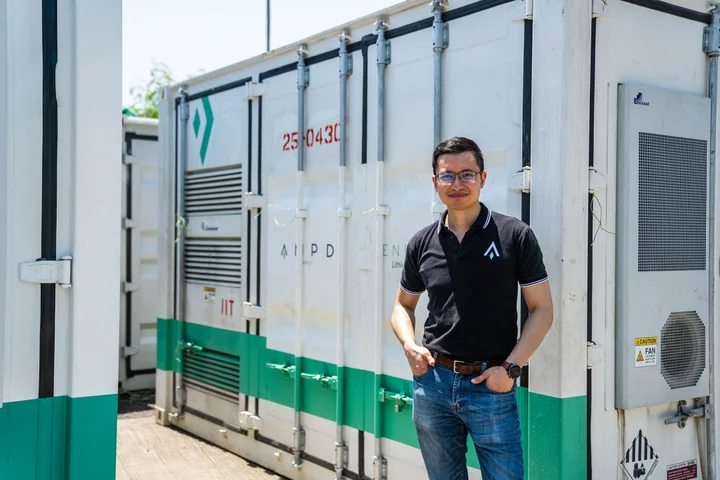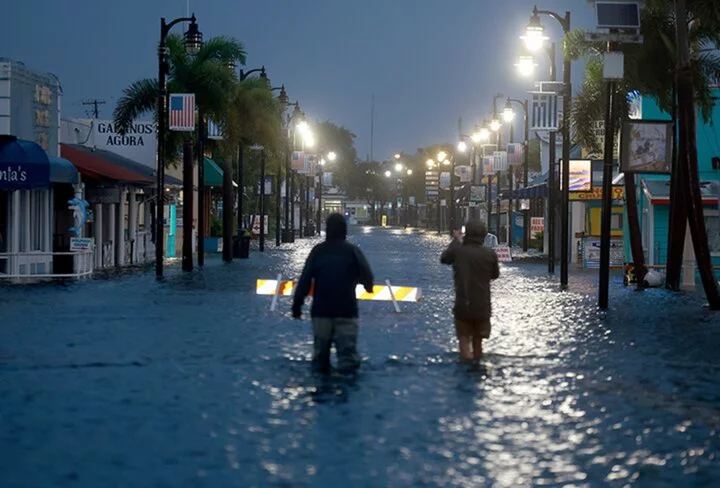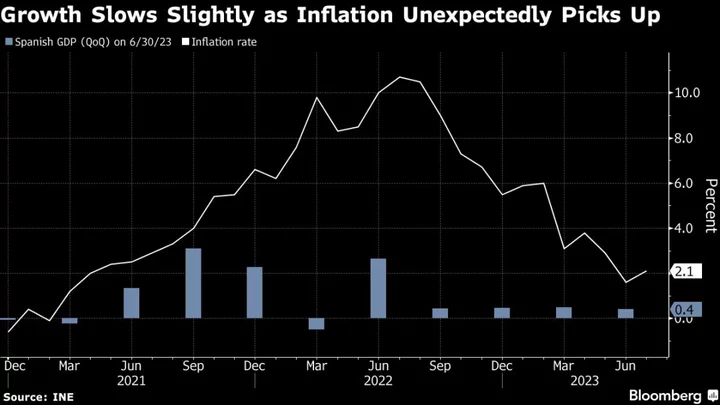When construction workers arrived to begin transforming Oslo’s Olav Vs gate into a pedestrian promenade, locals rolled their eyes. It was September 2019, and the prospect of a jammed turnaround zone for taxis becoming an even noisier, polluted construction site was viewed with disdain.
But the naysayers were in for a surprise. Almost all of the machinery used, from excavators to wheel loaders, was powered either by battery or directly from the grid. This meant the site was significantly free of engine noise and direct emissions, proving you can use electrified machines for most construction operations.
Construction, across its entire supply chain, is responsible for around 23% of all greenhouse gas emissions. Most originate in the creation of building materials (especially concrete and steel) or transporting them to where they’re needed. But around 5.5% of emissions come directly from construction sites—predominantly through the burning of fossil fuels that power machinery and generators.
These emissions may balloon with the global population. Around 2.5 billion more people will live in cities by 2050, according to the United Nations. To accommodate them, urban environments the size of Singapore are being built every month. To expand sustainably requires a radical reshaping of how structures are built—and hard decisions as to whether they get built at all. Novelties like the project at Olav Vs gate will need to become the rule.
“We’re on the verge of a boom in global construction,” said Irene Domínguez, a policy analyst at Bellona, a nonprofit based in Oslo that seeks to combat global warming. “That’s why it’s important that we have solutions that are low carbon but also scalable.”
Around 12% of Oslo’s emissions come from operating off-road machines, mainly on-site construction machinery, according to The Norwegian Environment Agency. Work on reducing that figure began in 2017, when the local government required all contracts for municipal construction be free of fossil fuels. It took a leap forward in 2019, when city officials started prioritizing contractors who use zero-emission equipment.
In total, the Olav Vs gate pilot project was able to save 35,000 liters of diesel and the equivalent of 92,500 kg of carbon dioxide. Philip Mortensen, a senior adviser to Oslo’s Climate Agency, said that’s the equivalent of taking around 45 cars off the road for a year. Which is to say, not very much at all.
What’s more important, according to Mortensen, is that these green construction sites are stimulating the market for electrical construction equipment. “We put this carrot on the market,” he said. “If you can provide us with a zero-emission service, then you will get a head up in the competition for projects.” With an annual investment budget of around €1 billion ($1.07 billion), the local government has about a 20% share of the construction market in Oslo, which is also a big incentive
Construction is among a handful of key industries inherently resistant to the green transition—much like ocean shipping and aviation.
Shipping is trying to make freighters more fuel-efficient while minimizing loitering times at port. Airports and airlines are seeking to trim emissions by cutting delays and optimizing routes. But in both cases, those strategies only nibble at the edges. The real solution is to replace fossil fuel—and for now, they can’t.
The same has been said of construction. But experts like Mortensen contend it may have a shorter path to sustainability. The City of Oslo Climate Agency estimated that last year, 55% of Oslo’s municipal construction work was powered by electricity and 43% used sustainable biofuels. Compared to the use of regular diesel, this amounts to around 10,000 metric tons of avoided CO2 emissions.
Read More: Why the Global Shipping Industry Can’t Clean Up Its Act
Still, those reductions come to only 1% of Oslo’s total emissions. “Sure this might not seem very impressive,” Mortensen conceded, but the target is to make all Oslo construction sites free of direct emissions by 2030. And more broadly, a number of other Norwegian cities have committed to the same goals, and the concept is spreading in other European nations.
Amsterdam has debuted fossil-free construction sites, as has Copenhagen, which operates its own fleet of zero-emission construction machinery. London, Milan and Budapest have signed the Clean Construction Declaration, committing to zero-emission sites and the promotion of low-carbon materials.
Construction “emissions are estimated at 40 million metric tons annually for Europe as a whole, roughly similar to combined greenhouse gas emissions from a small country like Denmark,” Mortensen said. “If we just assume Europe represents 10% of global construction emissions, this would amount to about 400 million tons annually,” he said. “For comparison, emissions from global aviation are just above 1 billion tonnes annually.”
“Cities, as the ones who procure construction works, have a big purchasing power that should be used for leveraging this trend,” Bellona’s Domínguez said.
Strides have been made in electrifying equipment once thought too power-hungry for anything but diesel. But such machinery is considerably more expensive. Electrified excavators and other larger equipment are also harder to find. Though a few of the main machinery manufacturers have launched lines for larger electric machinery, they have yet to scale up production.
Oslo has electric and biogas dump trucks that can be as big as 30 metric tons. The batteries in the most energy-intensive machines vary in size, from roughly 30-40 kwh on smaller systems to 390 kwh on a 30-ton digger. These machines operate for 6-8 hours and typically need a fast recharge only once during a full 12-hour work cycle, according to Mark Preston Aragonès, Carbon Accounting Policy Manager at Bellona.
Read More: How the Dirty Business of Air Travel Is Getting Slightly Greener
Another challenge is ensuring a sufficient power supply, particularly in remote construction sites. It can also be difficult to deliver power when a site is continually moving, like when laying stretches of road. “It all depends on what type of construction sites you have,” said Veronica Sund, an Oslo government specialist in zero-emission construction.
Brandon Ng, co-founder of London-based Ampd Energy, said his company makes an all-electric lithium-ion battery storage system that can power construction sites. He said it emits between 75% and 90% fewer emissions than traditional diesel generators, and that it’s been used in 140 construction projects across Hong Kong, Singapore and Australia. It’s becoming popular in Europe, where it powered three cranes on west London’s £1 billion ($1.23 billion) Olympia redevelopment.
Other construction companies have been exploring similar solutions. Two zero-emission hydrogen fuel cell generators were tested at the HS2 construction site in London last year, eliminating around 51 tonnes of carbon over 400 hours.
“We must be looking into decarbonizing the production of these materials.”
But the bulk of global construction emissions still comes from carbon emitted during the manufacturing and transport of building materials.
More than 70% of the world’s population live in homes made of reinforced concrete, which is very carbon intensive. Concrete production accounts for 8% of global greenhouse gas emissions, and the global iron and steel industry accounts for another 5%. To decarbonize construction, “we must be looking into decarbonizing the production of these materials,” said Dominguez.
Read More: The World’s Roads Aren’t Ready for a Hotter Climate
Magali Anderson, Chief Sustainability and Innovation Officer of Holcim, the Swiss cement maker, said the only way for low carbon building materials to become commonplace is through incentives. In Oslo, the city recently issued a large contract for the supply of asphalt based in large part on the emissions embodied within the final product.
According to Ándre Aasrud, senior adviser of Clean Construction at C40 Cities, a global network of mayors confronting the climate crisis, cities must also tackle the embodied emissions from a different angle. Besides trying to reformulate concrete, they should be working out how to use less of it. “The first and best solution is to reduce the demand,” he said.
There’s also the use of alternative building materials. Cities in India are making bricks out of fly ash while Scottish start-up Kenoteq uses construction waste. Architect David Benjamin is planning a housing complex in California using mycelium, the microscopic filaments that exist underneath a mushroom.
Another option is timber, which has the added benefit of creating a carbon sink in the built environment. In 2021, New York City approved timber in up to six-story construction and, late last year, California updated codes to allow for 18 stories. “The challenge is so massive that we have to look at all possible solutions,” said Aasrud. “And in some geographical contexts, timber makes a lot of sense.”
Sustainable construction also means recycling. In September, San Antonio, Texas, became the latest US city to pass a law requiring residential homes be deconstructed rather than demolished. The Dutch government meanwhile has introduced tax incentives for developers who register digital records of the specific characteristics and value of every material in a construction project. And Oslo has launched one of Europe’s largest hubs for second-hand building materials, featuring a physical storage space and a digital platform for professional operators who want to use them.
But more fundamental to making construction sustainable may be simply building less. Many buildings are empty much of the time, Aasrud said, creating an opportunity for repurposing them. “One thing is to reduce the carbon footprint of the materials,” he explained. “But there is a resource extraction issue. So it’s much better to reduce the demand overall.”









